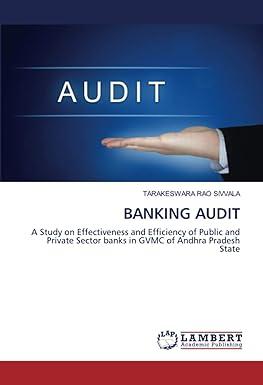Question
Plantwide versus Departmental Rates, Product-Costing Accuracy: Activity-Based Costing Ramsey Company produces speakers (Model A and Model B). Both products pass through two producing departments. Model
Plantwide versus Departmental Rates, Product-Costing Accuracy: Activity-Based Costing
Ramsey Company produces speakers (Model A and Model B). Both products pass through two producing departments. Model A's production is much more labor-intensive than that of Model B. Model B is also the more popular of the two speakers. The following data has been gathered for the two products:
| Product Data | ||
| Model A | Model B | |
| Units produced per year | 10,000 | 100,000 |
| Prime costs | $149,000 | $1,490,000 |
| Direct labor hours | 143,000 | 280,000 |
| Machine hours | 21,000 | 201,000 |
| Production runs | 50 | 60 |
| Inspection hours | 600 | 1,200 |
| Maintenance hours | 12,000 | 88,000 |
| Overhead costs: | ||
| Setup costs | $275,000 | |
| Inspection costs | 198,000 | |
| Machining | 496,000 | |
| Maintenance | 300,000 | |
| Total | $1,269,000 | |
Required:
Question Content Area
1. Compute the overhead cost per unit for each product by using a plantwide rate based on direct labor hours. (Round to two decimal places.)
Plantwide rate: $fill in the blank bc30aaff5024051_1 per DLH.
| Model A: | $fill in the blank bc30aaff5024051_2 overhead cost per unit |
| Model B: | $fill in the blank bc30aaff5024051_3 overhead cost per unit |
Question Content Area
2. Compute the overhead cost per unit for each product by using ABC. (Round rates and unit overhead costs to two decimal places.)
| Model A: | $fill in the blank dbb90e028f8906e_1 overhead cost per unit |
| Model B: | $fill in the blank dbb90e028f8906e_2 overhead cost per unit |
Note: Be sure to complete both tables below.
| Activity | Driver | Activity Rate |
| Setups | Production runsInspection hoursMachine hoursMaintenance hours | $fill in the blank dbb90e028f8906e_4 per runhour |
| Inspections | Production runsInspection hoursMachine hoursMaintenance hours | $fill in the blank dbb90e028f8906e_7 per runhour |
| Machining | Production runsInspection hoursMachine hoursMaintenance hours | $fill in the blank dbb90e028f8906e_10 per runhour |
| Maintenance | Production runsInspection hoursMachine hoursMaintenance hours | $fill in the blank dbb90e028f8906e_13 per runhour |
| Overhead assignment | ||
| Model A | Model B | |
| Setups | $fill in the blank dbb90e028f8906e_15 | $fill in the blank dbb90e028f8906e_16 |
| Inspections | fill in the blank dbb90e028f8906e_17 | fill in the blank dbb90e028f8906e_18 |
| Machining | fill in the blank dbb90e028f8906e_19 | fill in the blank dbb90e028f8906e_20 |
| Maintenance | fill in the blank dbb90e028f8906e_21 | fill in the blank dbb90e028f8906e_22 |
| Total overhead | $fill in the blank dbb90e028f8906e_23 | $fill in the blank dbb90e028f8906e_24 |
| Units produced | fill in the blank dbb90e028f8906e_25 | fill in the blank dbb90e028f8906e_26 |
| Overhead per unit | $fill in the blank dbb90e028f8906e_27 | $fill in the blank dbb90e028f8906e_28 |
Question Content Area
3. Suppose that Ramsey decides to use departmental overhead rates. There are two departments: Department 1: (machine intensive) with a rate of $3 per machine hour and Department 2: (labor intensive) with a rate of $1 per direct labor hour. The consumption of these two drivers is as follows:
| Department 1 Machine Hours | Department 2 Direct Labor Hours | |
| Model A | 9,000 | 135,000 |
| Model B | 150,000 | 250,000 |
Compute the overhead cost per unit for each product by using departmental rates. (Round to two decimal places.)
| Model A: | $fill in the blank a5ec60fcaffbf80_1 per unit |
| Model B: | $fill in the blank a5ec60fcaffbf80_2 per unit |
Question Content Area
4. CONCEPTUAL CONNECTION Using the activity-based product costs as the standard, comment on the ability of departmental rates to improve the accuracy of product costing. Did the departmental rates do better than the plantwide rate?
A common justification is to use
machinelabor
hours for machine-intensive departments and
machinelabor
hours for labor-intensive departments. Using activity-based costs as the standard, we can say that departmental rates
increaseddecreased
the accuracy of the overhead cost assignment for both products. The departmental rates cost A well
abovebelow
the ABC method while the plantwide rate costs A well
abovebelow
the ABC method. However, the rates of difference are very close. Looking at it this way, department costs are not clearly more wrong than the plantwide rate; they are wrong in a
differentsame
direction. The departmental rates
diddid not
do better than the plantwide rates.
Previous
Step by Step Solution
There are 3 Steps involved in it
Step: 1

Get Instant Access to Expert-Tailored Solutions
See step-by-step solutions with expert insights and AI powered tools for academic success
Step: 2

Step: 3

Ace Your Homework with AI
Get the answers you need in no time with our AI-driven, step-by-step assistance
Get Started


